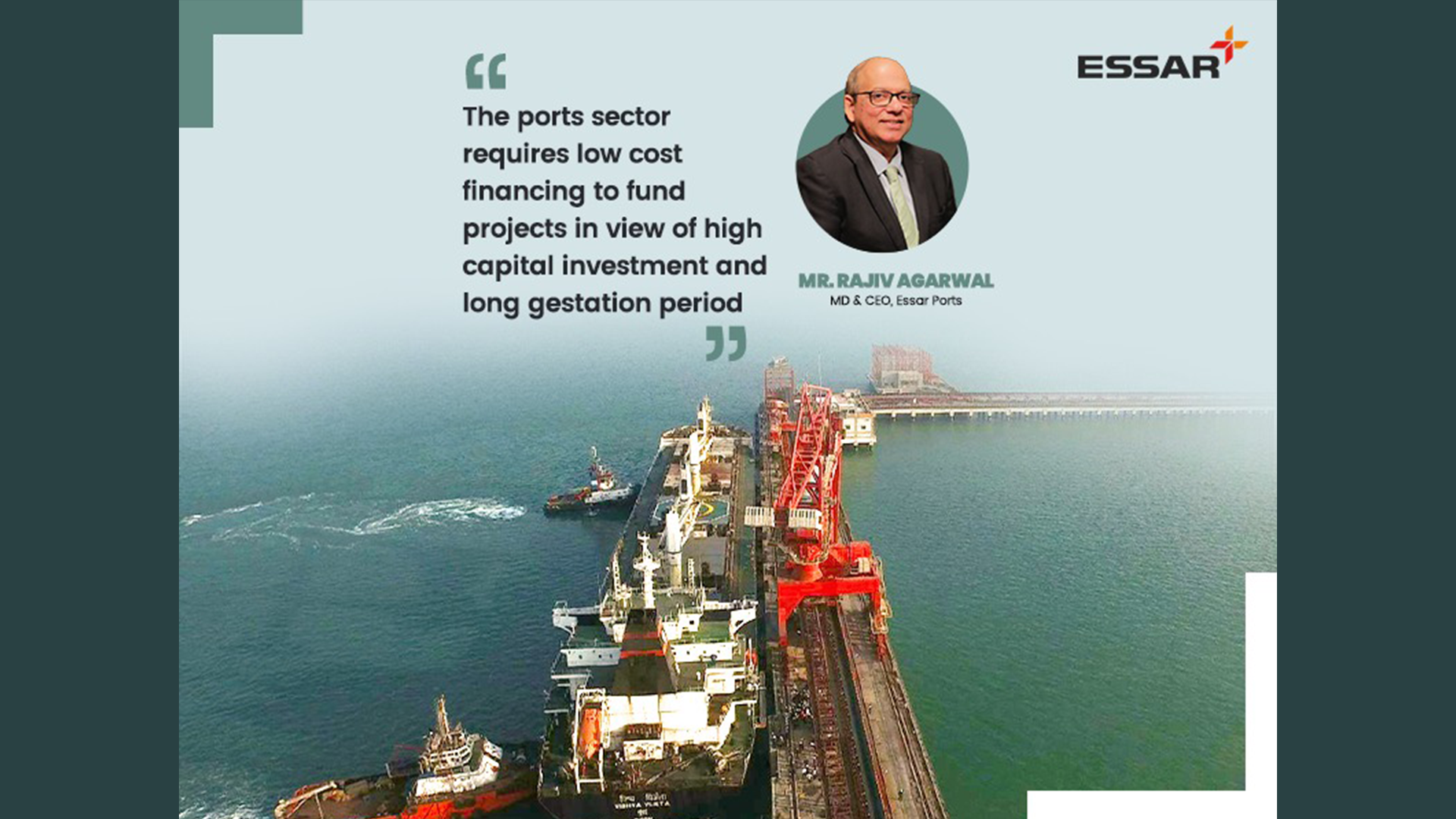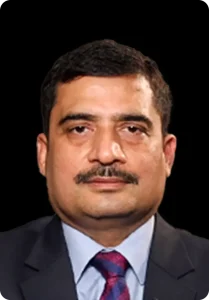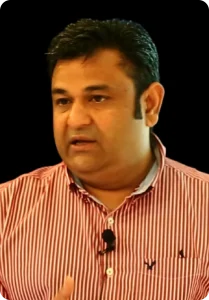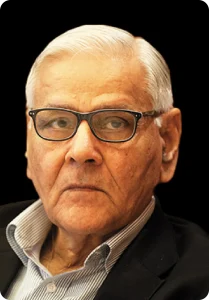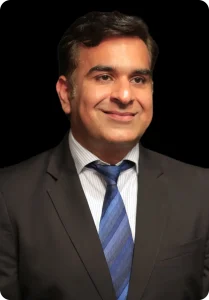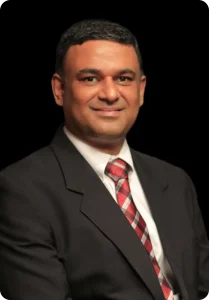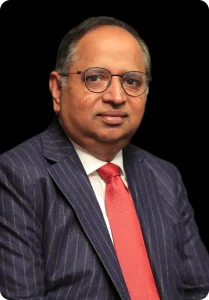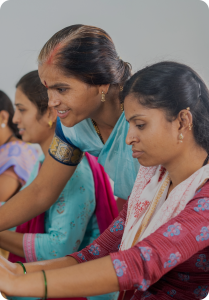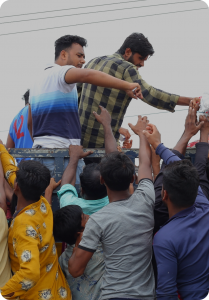- Karvi Rana, Logistic Insider Magazine
Mr Rajiv Agarwal, Managing Director & CEO, Essar Ports shared his views with Logistic Insider Magazine on how the ports sector requires low cost financing to fund projects in view of slow cargo build-up and long gestation period.
Below are excerpts from the interview.
India in the past few years has set high ambitions for itself. Considering that about more than 90% of India’s trade by volume is conducted via the country’s maritime route, there is a continuous need to develop India’s ports and trade-related infrastructure to accelerate growth in the manufacturing industry and write the Indian success story. In this feature, we reflect on the Port Modernization initiative of the nation, identify the gaps in the port infra and look at the benefits that the Indian economy can reap through the modernisation of the Indian Ports.
Blessed with a vast coastline, occupying a commercially enviable location on the globe -straddling the Indian Ocean, the Arabian Sea, and the Bay of Bengal, India’s coastal front and backyard are home to vibrant Indo-pacific economies giving the ports of India the potential to contribute significantly to the country’s economic growth. Sadly, the potential is unmet on the back of poor shipping connectivity, lack of infrastructure, and regulatory support.
Attesting to the same was a piece of recent news indicating the inability of the nation to attract bigger container ships and fulfil its dream of becoming the world’s factory.
As reported, vessels like the Ever Alot, the world’s largest box ship at 400 meters long and with a capacity of more than 24,000 TEUs skipped India and visited neighbouring nations like Sri Lanka and even Malaysia due to lack of depth in most harbours along India’s coasts.
Also, a report by the Reserve Bank of India in 2022, states that poor shipping connectivity has hindered India’s integration into the global value chain. The country scored 34% in the GVC participation index compared to 45.9% for the 10-member Association of Southeast Asian Nations, the RBI said, thus indicating the importance of modernizing ports in India to improve its trade and economic growth.
“The cornerstone of the economic welfare of any country is the presence of a performing infrastructure. Seaports are a critical part of this infrastructure and essential to boost and support the economic development. In that respect, any plan to modernize and revitalize the port system should be encouraged,” Luc Arnouts, Vice President International Relations and Networks, Port of Antwerp-Bruges said.
EXISTING INITIATIVES
The Government of India has already commenced its journey of building a modern port infrastructure system in the nation by launching several initiatives.
Let’s look at a few of them in brief:
- Sagarmala Project: This is a flagship project of the Government of India that aims to modernize the ports and their hinterland connectivity. The project focuses on developing new infrastructure, enhancing the existing ones, and connecting ports to the hinterland through road, rail and waterways. Mr Arnouts acknowledges the significant investment put in by India in the modernization of its ports to improve their efficiency and capacity.
- “Sagarmala projects includes projects from various categories such as modernisation of existing ports and terminals, new ports, terminals, RoRo & tourism jetties, enhance-ment of port connectivity, inland waterways, lighthouse tourism, industrialization around port, skill development, technology cen-tres, etc. These projects are broadly classi-fied under Sagarmala,” he highlighted.
- Maritime India Vision 2030: The government has launched the Maritime India Vision 2030 to enhance the competitiveness of the Indian maritime sector. The vision outlines various measures, such as increasing port capacity, improving connectivity, and introducing green technologies.
- Port Community System (PCS): The government has introduced PCS, which is an online platform that connects all stakeholders involved in port operations. It facilitates a paperless environment, thereby reducing transaction time and costs. The PCS is now upgraded to NLP Marine, which makes the entire logistic ecosystem more efficient, beneficial for EXIM trade and create more opportunities for specialized jobs’.
- Green Ports: The government is promoting green technologies in the ports, such as using renewable energy sources, eco-friendly vehicles, and improving waste management systems.
- Sagarmala National Perspective Plan (NPP): The NPP is a long-term perspective plan that aims to develop India’s coastal and inland waterways. It focuses on improving connectivity and enhancing the efficiency of waterway transportation.
Complementing these initiative and part of the government’s holistic approach for comprehensive development which can boost the economy in the long run are initiative like National Infrastructure Pipeline and PM Gati Shakti NMP for Multi-Modal Connectivity.
But are we still missing something?
COURSE CORRECTION
Despite the aforementioned initiatives, India needs a set of alternate mechanisms which can help expand port capacity and can then bring down the logistics costs.
“A few more things that can be done are: promoting DPD (Direct Port Delivery) & DPE (Direct Port Entry) to help facilitate container trade, regulate shipping lines, promote domestic shipping lines, and ensure transparency in shipping line charges & operations,” says Christian Roeloffs, Co-founder and CEO, Container Xchange, an online container logistics platform.
The ports sector has a crucial role to play in nation-building, and implementation of mechanisms to enable flexibility in long term concessions to ride out the evolving market dynamics and other risks impacting projects and operations is required.
According to Rajiv Agarwal, Managing Director, Essar Ports, “We need to address the issue of hinterland connectivity through road and rail for ease of evacuation from ports & terminals as well as improve the quality of port services through service levels benchmarked with the best across the globe. Other areas that need focus are dearth of low-cost long duration funds, non-equitable risk sharing in PPP projects between Concessionaire and concessioning authority, the high logistics cost impacting exports competitiveness and low base cargo and manufacturing industries, which are essential for greenfield projects viability.”
He adds, “Additionally, the ports sector requires low cost financing to fund projects in view of slow cargo build-up and long gestation period. Low cost financing solutions for debt & equity should be opened for the private sector to enable their participation in the current National Infrastructure Pipeline.”
India’s ports for decades have been protected from natural competitive forces – the participation of large scale, cost-effective ships and the availability of employees eager to work longer hours and at competitive wages. They also have been shielded from adopting the technological advances in logistics operations that world class ports elsewhere around the globe have enthusiastically embraced.
In agreement, Mr Roeloffs, further mentions some of the pain points that should be addressed.
- TECHNOLOGY: Indian ports need to adopt modern technologies such as automation, the Internet of Things (IoT), artificial intelligence (AI), and big data analytics to enhance efficiency, reduce turnaround times, and improve overall performance.
- CAPACITY: India’s ports need to be expanded and their capacities increased to cater to the growing volume of trade. The current ports are often congested, which leads to delays and increased costs.
- REGULATORY FRAMEWORK: The regulatory framework governing the ports should be streamlined and made more business-friendly. Simplifying customs procedures and reducing bureaucratic red tape can help reduce delays and costs.
- ENVIRONMENTAL CONCERNS: The ports should focus on reducing their environmental impact by adopting green technologies, such as renewable energy sources and electric vehicles, and improving waste management systems.
- HUMAN RESOURCES: Skilled and trained personnel are essential for efficient and effective port operations. Training and development programs should be implemented to enhance the skills of the existing workforce and attract new talent.
- SECURITY: Ports should have a robust security system in place to ensure the safety of personnel, cargo, and infrastructure.
- COLLABORATION: Collaboration and partnerships between various stakeholders such as port authorities, shipping lines, logistics companies, and the government are essential to ensure the smooth functioning of the ports and promote their modernization.
BENEFITS TO REAP
Once the initiative and efforts taken by the Indian government concerning the modernization of ports begin to pay off, they will bring in the obvious advantage of optimizing processes and different stages of a supply chain also stimulate the development of an economy at all levels, making it interesting not only to government agencies but also to the port manager and customers utilizing the seaports.
Mr Arnouts, while discussing the strong similarities between the initiatives taken by the Indian government under the Sagarmala Project and the initiatives at the Port of Antwerp Bruges, said, “To ensure sustainable growth and to secure Antwerp’s position as a hub in the global market, we have been continuously upgrading our infrastructure and adopting new technologies to prepare our port for the future and make it more efficient, safer and smarter.”
He goes on to say, “We believe that the initiatives taken by India are very crucial and will lead to expedited growth in the maritime sector in the nation. The transition towards a more autonomous way of working has proven to be beneficial and has allowed the port to be a strong competitive international player resilient enough to face future challenges.”
Mr Agarwal speaking on the benefits say the modernisation of seaports has multi-pronged benefits for all stakeholders such as – enhanced supply chain visibility, reduced turnaround time, lower logistics costs, optimum utilization of resources and fleet, safety & security with better quality life for users and maximizing profits. “It effectively paves way for EXIM growth of any economy,” he added.
Mr Roeloffs lists down the benefits of modernizing seaports for different stakeholders:
INVESTORS: Can gain higher returns and new investment opportunities.
SHIPOWNERS: Can benefit from reduced turnaround times and costs, increased vessel utilization, and improved safety.
LOGISTICS OPERATORS: can have faster turnaround times, increased reliability, and better customer service.
CUSTOMERS: Can reduce inventory holding costs, streamline trade processes, and improve supply chain visibility.
A modernised port infrastructure and efficient services will enable the engines of the economy to work in full swing thereby ensuring economic development as well as EXIM competitiveness of the nation.
Mr Agarwal says, “As India charts its way towards a US$ 5-Trillion economy and on becoming a global economic powerhouse, there will be pockets of production and consumption centres. Overall, there will be huge growth in logistics requirements for inland and EXIM cargo movement. Building future-ready, resilient, and sustainable infrastructure will pave way for a boost in manufacturing & cost-effective logistics.”
With infrastructure development initiatives to modernize and revitalize, Indian sea ports can help enhance the nation’s position as a trade partner in the global supply chain.
“Infrastructure development would help Indian ports handle larger cargo volumes and improve turnaround time, which would result in increased efficiency, reduced transportation costs, and better trade outcomes. This can, in turn, lead to economic growth by increasing employment opportunities, attracting foreign investment, and boosting the overall GDP,” says Mr Roeloffs.
Further, digitalization including cargo tracking, real-time monitoring of port activities, and automation of administrative procedures will play a crucial role in modernizing and revitalizing Indian sea ports by improving efficiency and reducing costs by automating and streamlining port operations.
“Digitalization can result in significant cost savings, improved transparency, and enhanced security, leading to better trade outcomes, higher port productivity, and increased economic growth,” Mr Roeloffs said.
This will bring transparency and clarity of work, streamlined communication by a web-based system, and a paperless regime.
“With enhanced efficiency, safety, and competitiveness, seaports can become a catalyst for increased trade and economic growth, creating a win-win situation for all stakeholders involved,” Mr Roeloffs said, adding that achieving this requires a collaborative effort from all stakeholders to invest in port infrastructure and implement advanced technologies.
CONCLUSION
Indian sea ports have the potential to become major hubs of global trade and with the right policies and investment it can be a significant contributor to the country’s global trade value. The success of these initiatives can promote sustainable development, create new opportunities for growth and employment, and contribute to the country’s economic growth.

